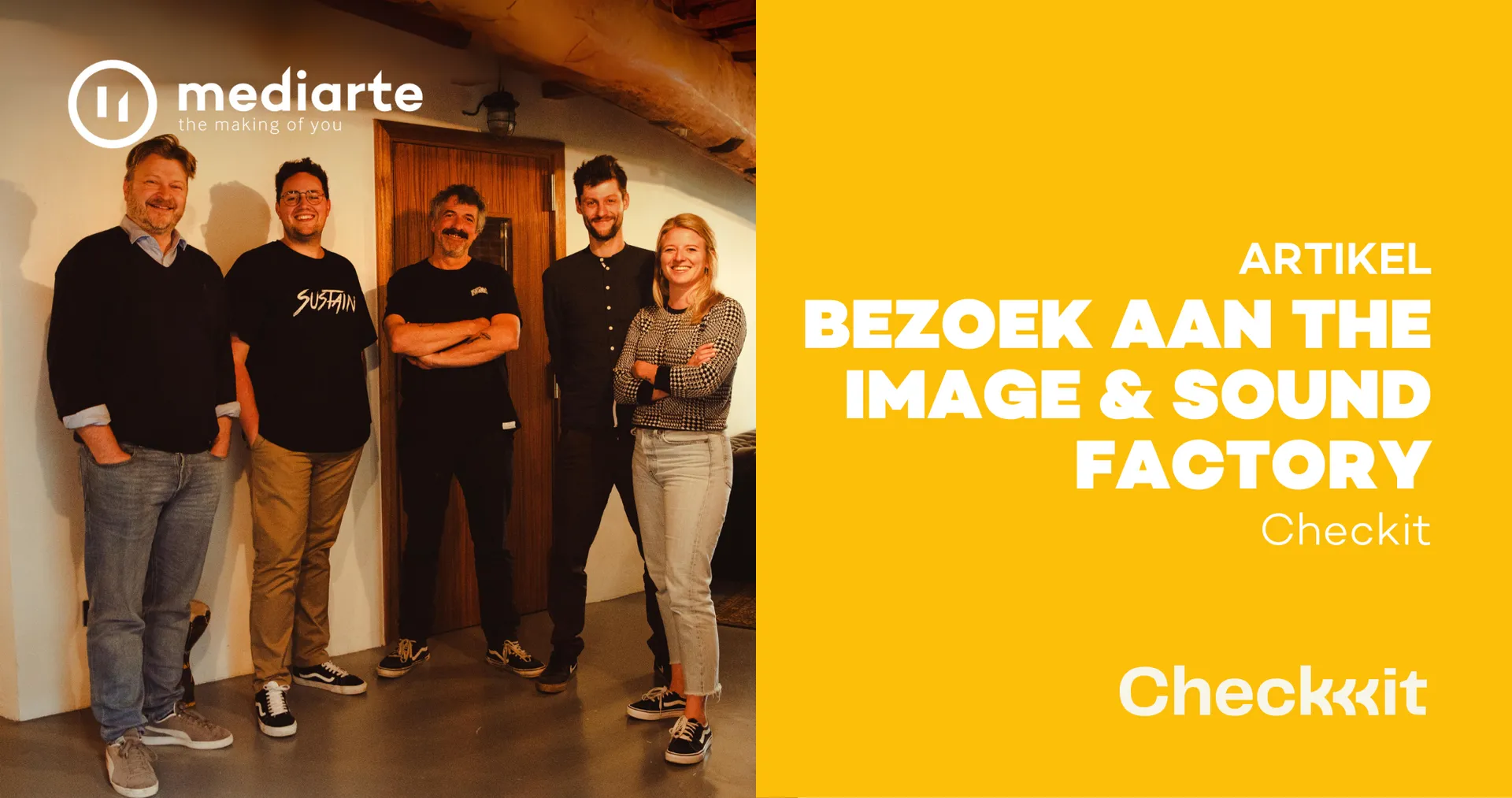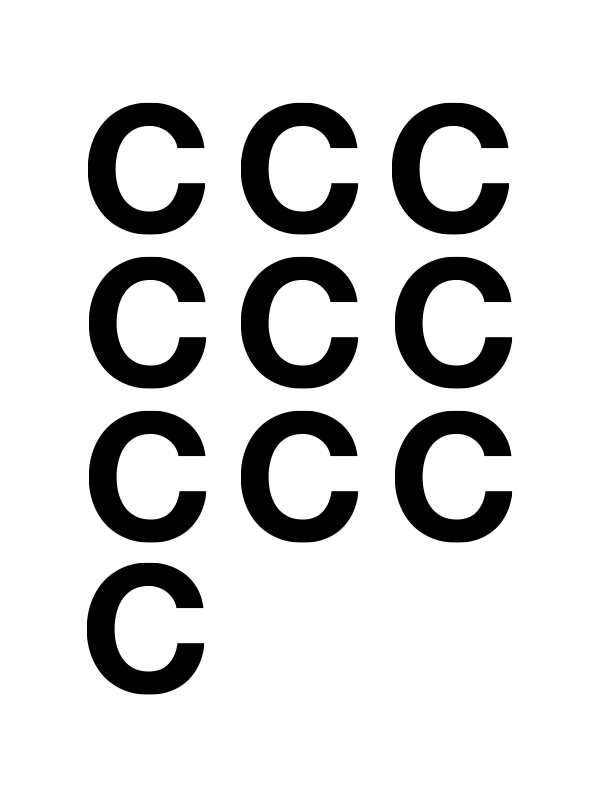Which comes first? Sound or image?
7 min read

This article by Geert Genbrugge, from CYANOTYPES project partner, Mediarte, explores the dynamic learning culture and strategic approaches of The Image & Sound Factory, highlighting improvement and teamwork in the audiovisual industry.
Quiet on the set please. Roll sound. Sound running. Roll Camera. Camera running. Slate in: Scene 1 Take 1. Clap. Action. Cut. Coffee.
After the imperative demand for absolute silence – the dresser is not allowed to drop a pin from between the lips – there is first the sound, then the picture.
When the scene is done, and everyone is stunned by the players’ magisterial acting, the razor-sharp word follows: Cut. The recording of image and sound are abruptly cut off. The magic is still in the air. Murmurs.
And then there is no coffee. Not yet. Coffee doesn’t belong in this list. It would be nice, but it’s not. Just after a recorded scene, the focus has to stay with the shot. The first thing to consider is whether the shot is usable, sufficient, should be redone -for whatever reason- and whether preparations for the next shot or scene can be started. This decision requires seriousness and mental space because in a few seconds quality, money and time are weighed against each other. These three factors constantly influence each other.
Only when the scene has been captured from all points of view and the team starts preparing the next scene, only then – and not before – is there time for coffee. Perhaps. With reservations. Nothing is certain. The person who perfectly senses when coffee may be poured and passed around possesses an incredibly valuable sense. But all this is completely aside.
The role of Checkit
As a reminder. Checkit is a free coaching programme for SME’s funded by Europe and Flanders. Mediarte helps identify the competencies that are present and those that are not yet present. Both management and employees are involved in the conversations. The learning culture of the organization comes into focus. The aim is to think about strategic actions that respond to digital, high-tech and climatic changes. Training each other and sharing experiences has become the most important competence.
The Image & Sound Factory
For the first competence scan as part of Checkit, I was invited by Pedro Van der Eecken, founder -and together with partner Geert Vlegels- driving force behind the sound studio The Image & Sound Factory in Dendermonde (Belgium). The office and sound studios are located in the buildings of an old soap factory. Together with the golden yellow morning sun, the characterful red brick, the stately combustion tower and the industrial look exude an Italian cinematic atmosphere. No more the smell of soap. But the smell of freshly roasted coffee beans. Indeed, as you enter, you pass coffee roaster Agostini, located in the former steam room. Coffee roasting is an aromatic competence here.
The Image & Sound Factory specialises in audio recording, dubbing, mixing, editing, mastering and finishing of fiction projects, TV series, short films, non-fiction, reportage, documentaries, commercials, animation and podcast. Nationally and internationally.
Together with Pedro and production coordinator Anna De Lepeleere, I explore their organisation’s learning culture. It very quickly becomes clear to me that the concept of lifelong learning has been unflinchingly cultivated here for years. After all, competency thinking is indispensable for the continuity of their existence. The Image & Sound Factory evolves with new and innovative evolutions and constantly adapts to changes in the audiovisual landscape.
Employee curiosity and eagerness to learn do not need to be instilled. They are ingrained. The supportive conditions and stimulating context ensure that these traits are continuously nurtured.
From all evidence, The Image & Sound Factory encourages their employees to get better and better at what they do. A lot of healthy, happiness-inducing dopamine is released in this factory. Author Daniel H. Pink, in his book Drive, the surprising truth about what motivates us (2020, 85), names three things that contribute to this: autonomy, mastery and meaningfulness. All three characteristics are put into practice at the sound factory. Because they find that this empowers employees and contributes to everyone’s well-being.
Every entry-level employee is given ample time to develop. The first year is learning by watching, listening, following and assisting colleagues. Then, new employees are given small assignments to work on. The end result does not have to be delivered yet and is not tied to deadlines. Practise-practise-practise and do-do-do are the credo. Trying something out, searching and finding. Trial and error. Again, again and again. Based on small tasks, employees learn all aspects of the project, software and hardware. Employees report that their learning curve rises spectacularly during these first two years. Belief in their own abilities grows, autonomy increases, mastery takes shape and the feeling prevails that a meaningful contribution is being made.
John G Avildsen’s 1984 film The Karate Kid suddenly comes up. I vividly remember the iconic kicking technique Daniel LaRusso uses during the karate tournament finals mimicking the stance and movement of the crane. As kids, we imitated that jump. Pedro, however, refers to the “wax on, wax off” approach from the story. New employees are given labor-intensive tasks to perform day after day without the result being important, the learning process all the more so. It expresses the confidence and patience an employee must have in their own development. It is about the number of hours it takes to master the job. An employee is given the responsibilities that come with the job only when the employee is ready.
Suddenly the conversation switches to the role of education. The industry notices that graduates no longer have the necessary competences. After three or four years of study, they have insufficient practical experience. They know and can do too little. Their creativity is not the problem. Their technical skills are underdeveloped. The conclusion is that there is a need for consultation and dialogue between the professional field and education. The professional field is in demand.
Conclusions from the conversations
Interviews with sound engineers Brozi and Renzy show that the organisation’s mission and vision is supported by everyone and contributes to a strong connection between them. Working together and working as a team are the core concepts that keep coming up. They form the DNA of the organisation. Working on an audiovisual project is teamwork. You cannot work without the other. Employees indicate that at every stage of a project, they consciously consider the next step in the creation process and the working methods of colleagues. Performing a task essentially comes down to preparing the task of the employee who continues to work on the work done. Collaboration simultaneously requires a high degree of independence. Being able to work independently is complementary to working together. The more autonomously someone is allowed and able to work, the stronger the cooperation. This is perceived as meaningful.
Each employee works his or her way up to become an expert in a part of the task and helps the others with their expertise to achieve a higher goal together. In this way, it is very easy for the team to get motivated (Ludodidactics, Renger & Hoogendoorn).
Before each project, the team sits together to talk through the workflow. These meetings are the backbone of each project. Knowledge of the complex network system and of the workflow is crucial. After all, those who know the workflow are able to do error detection and problem solving efficiently. These discussions save time and increase efficiency and effectiveness.
Central to competence thinking is the passing on of experience. Experience is the sum of all the projects worked on over the years. The importance of this cannot be overemphasized. Experience is the cornerstone of the organization. The experience and knowledge that Pedro and Geert represent is invaluable to the company.
Self-study is a term that drops a few times. “Two nights and a lot of research” provides answers to difficult questions. Those who read something new or delve into an aspect of the job talk about it over lunch, during corridor discussions or at the coffee machine. Self-study always leads to the exchange of new insights and information.
It is also only natural tomonitor your own field. This happens both informally and formally during team meetings.
Because of new developments in software packages, rapid digital changes in project execution and directors who are “very demanding”, most complex questions are project-related. Pedro prefers to put his own energy and time into solving problems. That is what drives him. And it keeps the knowledge in-house.
Error detection and problem solving are competencies that are used every day. The organization has developed its own WIKIpedia in which every problem that has ever occurred is listed and written out. Every employee has access and writing rights to these files. This WIKI also contains all the procedures and protocols, standards and guidelines needed to carry out and deliver projects. Collecting and consulting is standard work.
The learning culture and constant exchange of knowledge has the ultimate goal of keeping every employee “up to the task”. The Image & Sound Factory trains every employee on the principle: how many times do you have to redo something before it is right from the first time? Every project delivered complies with the self-imposed quality label and therefore also with the strict standards and requirements of the broadcast and streaming platforms. No returns to sender.
Tight budgets, limited financial room and ever-increasing time pressure force the organisation to constantly think creatively about strategic choices. In a market where “good, is good enough” is sometimes a defensible choice, The Image & Sound Factory chooses to bet resolutely on quality: only the best is good enough.
Meanwhile, Geert Vlegels – doing the job of a foley artist – is recording sounds in the big studio. Anna has to come over to help. Pedro gets a call. A conversation he needs to record. Renzy and Brozi have a coffee together. The magic of the conversations along with a convivial atmosphere still in the air. It feels like the silence after recording a scene from masters of sound. Focus.
We are ready. Ready for the next scene, for the next competence scan.
Thanks to Pedro, Geert, Anna, Renzy and Brozi.
This article was written by Geert Genbrugge
Related content
Organising Learning in Regenerative Systems: The triple loop is the message
This essay introduces CYANOTYPES, a collaborative multi-year research project that set out to explore and address how people across the creative sector — arts, culture, and design in all their manifestations — might organise learning in the (immediate) future, and outlines a creative agency model to facilitate the development of curricula and custom learning journeys, contending that especially in the context of the growing role of intelligent systems in the creative process, a focus on creative agency makes sense to frame the analysis as well as the design of learning processes.
By Soenke Zehle, Sónia Alves, David Crombie, and Esko Reinikainen
